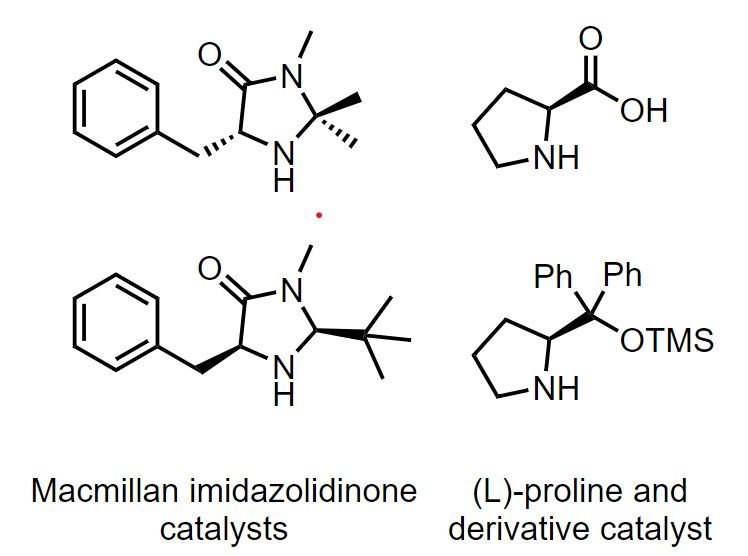Benjamin List and David W.C. MacMillan were awarded the Nobel Prize in Chemistry this year for “the development of asymmetric organocatalysis.”
What is this? What is its contribution to the scientific community? Let’s dive in.
One might not realize the importance of catalysts but did you know that seven Nobel prizes in Chemistry have been awarded in this field? With the earliest accolade being given almost a century ago. But what are catalysts though? Well, catalysts are an essential ingredient to many industries and scientific projects. These substances are capable of controlling the rate of reactions without influencing the components. The two Nobel laureates individually came up with a type of catalysis (the process of altering the rate of chemical reactions through catalysts) called, you guessed it, asymmetric organocatalysis.
And this novel method of generating new molecules is "precise, cheap, fast and environmentally friendly."

The concept of mirror images or handedness: Before we go further, let's understand the concept of "handedness."
Put very simply, a molecule can have different spatial arrangements. And enantiomers are a pair of molecules that exist as mirror images of one another but aren't superimposable. A single molecule can act/perform differently depending on its handedness. For example, Aspartame, the artificial sweetener has two enantiomers. L-aspartame tastes sweet but D-aspartame is tasteless. Enantioselective synthesis makes it possible to generate a specific type of enantiomer and during catalysis. The knowledge of asymmetric or enantioselective reactions is an indispensable requisite.
Other ways for catalysis and their drawbacks
Transition metals and enzymes were the two other enantioselective catalysts employed but they both had their own drawbacks. The metal catalysts are expensive, detrimental and toxic to the environment. Plus, a great deal of effort is necessary to ensure that the final product is free of any lethal contamination. On the other hand, the enzyme catalysts, which are present in abundance in our bodies are of considerably larger sizes compared to the target particles which lead to various logistics complications. And they take a lot of time to be prepared and utilized efficiently under laboratory conditions since they don't work well outside the body.
Why is organocatalysis an important development?
This process is far more environment-friendly and cheaper to produce. These are more chemically stable during the reactions owing to the carbon present in them which facilitates the other elements to ably bond.
Pernilla Wittung-Stafshede, a Nobel committee member said that this is an ‘elegant tool’ that is ‘simpler than one could ever imagine.’
Another advantage of organocatalysis is that this mechanism prevents the wastage of products and energy by eliminating the intermediate steps of purification. Previously, after each step, each intermediate product had to be isolated and filtered to dispose any unnecessary by-product.
How does it actually work?
The organocatalysts have their own fixed handedness. So when they bind the reacting substances or target molecules, called the substrate molecule, an intermediate is created that's even more reactive than the substrate molecule itself. The catalyst will then be able control which part of the intermediate will react by "transferring" its handedness to the substrate. Thus ensuring an efficient and sped up reaction process.
What did List and MacMillan do?
The laureates studied organic molecules for asymmetric reactions during the early 2000s. List experimented with biocatalysts to observe their chemical nature. Chemistry World published an article that explains, "The enzyme Aldolase A performs aldol reactions – combining two carbonyl compounds to create a new carbon–carbon bond in the body. But it is really only three amino acids that are responsible for its catalytic activity. In 2000, List and his team found out that one of them proline can on its own catalyze asymmetric aldol reactions with enantiomeric ratios up to 98:2."
And MacMillan, unaware of List's work had also developed a catalyst that yielded the same result for another reaction. Namely, the Diels-Alder reaction. He wanted to overcome the drawbacks of the moisture and air sensitive behavior of the metal catalysts.
After this development, the field has seen tremendous advancements and has led to a myriad of new applications in a variety of industries. Organocatalysis has been acknowledged as one the pillars of catalysis along with enzymatic and metal catalysis. In conclusion, organocatalysis was an obvious solution that made all our lives a tad bit easier, efficient, and far more greener.
‘The real revolution of our discovery is only surfacing now with extremely reactive catalysts that can do stuff that you cannot do with enzymes or even with the most sophisticated metal complexes,’ said List.

